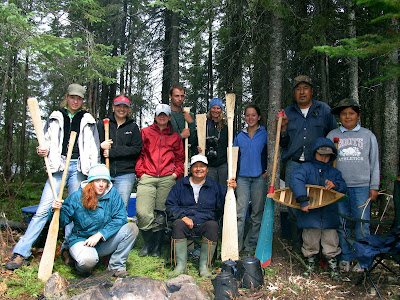CES has been coaching tourism officers, entrepreneurs, managers and Community Leaders in sustainable tourism development for over 15 years! The tremendous success of this program and it’s ‘graduates’ has been incredibly rewarding for not only the communities they work in, but for our team as well. We have been given the wonderful opportunity to forge strong working relationships as well as friendships. This is why we have decided to start a ‘video coaching series’ by the man who started it all – Clinton Belcher – and we would like to invite you to participate. Clinton will be providing advice and tips on developing your skill set as well as innovative ideas and concepts for sustainable tourism development. We will be starting the series in the coming weeks – keep an eye out on our facebook page, twitter, blog and YouTube channel for details and videos!
Wednesday, March 28, 2012
Friday, March 23, 2012
RFP - Assembly of First Nations National Youth Council
The Assembly of First Nations (AFN) National Youth Council (NYC) is planning to hold the 4th National Youth Summit: Youth Leadership Supporting the Way Forward, in the Summer-Fall of 2012. For the RFP, visit - http://www.afn.ca/uploads/files/rfpafnnycannualconference.pdf
Tuesday, March 20, 2012
Cree Nation of Nemaska, QC
Through a collaborative process, CES has been
working with the community of Nemaska in Northern Quebec in developing their community
into an international destination. CES was hired to facilitate the training
and coaching program for the community’s Tourism Officer. Subsequently, a Pando
Terra Community Tourism Plan was developed in consultation with the community.
The plan provided a holistic approach to sustainable community development,
ensuring long term success. The plan detailed tourism opportunities
highlighting the community’s unique culture and history, and provided
recommendations for their implementation. CES continues to work with the
community, developing a variety of marketing initiatives, including a brochure,
website, community signage and luggage tags.
Aboriginal Tourism Ontario Strategy
The goal of the Aboriginal Tourism Ontario
Strategy – Phase 1 was to listen to the voices of Aboriginal tourism business
in Region 13A and objectively assess their current state. A categorized
inventory of Aboriginal businesses representing a cross-section of tourism sectors was developed. Through a comprehensive stakeholder
engagement process, the main challenges, opportunities and recommendations were
identified and assessed. Phase 1 identified opportunities for product
development, training, a cultural authenticity program and marketing and
packaging. Phase 1 recommended moving forward with an Aboriginal Tourism
Ontario organization.
Phase 2 saw the development of an
operational business plan for Aboriginal Tourism Ontario and was built on the
strategic priorities identified in Phase 1. This included developing an
effective management structure and organizational framework for the provincial
organization. An implementation plan was developed for the four directions
the organization is built on including product development, human
resources, cultural authenticity and marketing and branding. The mandate of
Aboriginal Tourism Ontario will be to support, recognize and market Aboriginal
tourism businesses and communities in Ontario and grow the tourism receipts of
Aboriginal businesses.
Destination Eeyou Istchee - Footsteps and Paddle Strokes - Cree Outfitting and Tourism Association, QC
The Footsteps
& Paddle Strokes project was designed to create a tourism strategy that
would unify a region through the development of complementary tourism products
in harmony with a cohesive branding strategy. CES
designed a process to develop Eeyou Istchee - the James Bay Region of Northern Quebec - into an international tourism
destination through a collaborative approach consulting with industry partners community
members, key stakeholders and funders.Once complete,
the findings from these extensive consultations were compiled and
recommendations put forth to best reflect the interests of the community
members. A comprehensive plan was developed to
ensure COTA’s vision of creating a dynamic regional tourism plan that linked 9
Aboriginal communities through thematic cultural & arts routes with
appropriate programming. The result is a uniquely stakeholder-driven blueprint for regional
tourism success.
City Square - Redevelopment of Victoria Park - Regina, SK
The WOW Project, a component of the Regina
Downtown Plan, plans to expand Victoria Park into a focal point and festival
space for downtown Regina. The project has become a reality in City Square. A significant element in the City
Square project was to consult and inform those people who will be the park
users once the project is completed. CES engaged in an extensive stakeholder consultation process termed WOW2
with the objective of:
“Helping us to make better decisions about
expanding Victoria Park into a vibrant city square.”
The purpose of the stakeholder
consultations was to inform, consult, listen and learn. The stakeholder
consultations occurred in two rounds. The first round methodologies included
random surveys, one-on-one meetings, formal and informal meetings, telephone
interviews and web-based surveys to identify their opportunities, challenges
and recommendations. The second round methodology consisted of numerous
roundtable discussions to confirm what was heard during the first round and to
develop the program of uses for the park.
108 various stakeholders were engaged
during the first two rounds of consultations, which included:
- 40 park users
- 45 stakeholder groups
- 10 residents
- 13 arts and culture groups
Hundreds of
stakeholder comments were received during the first rounds of consultation,
which were analyzed and categorized into recurring topics. The recurring topics
were further distilled into 11 common themes. From these themes, 4 pillars were
developed to serve as guiding principles in the design, expansion and end
use of City Square.
The stakeholder consultations culminated in
a final public viewing and neighbourhood celebration in Victoria Park. The
neighbourhood was invited to Victoria Park to view the various components of
City Square including the stakeholder consultations, traffic and transit and
the conceptual design plans for City Square. People in attendance were given
the opportunity to provide feedback of the event and the project to date. The
event was very well received and attended with over 400 residents of Regina
attending.
The stakeholder
consultation process was an integral part of the City Square project as it
provided a forum for which stakeholders could voice their opportunities,
challenges and recommendations for the park as it related to them. It provided
a context for which the citizens of Regina could help create a park that will
become the jewel of downtown.
Subscribe to:
Posts (Atom)




